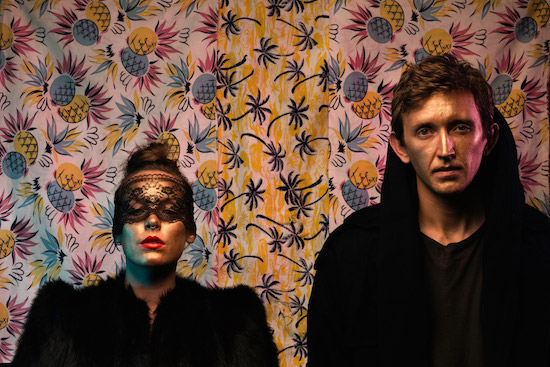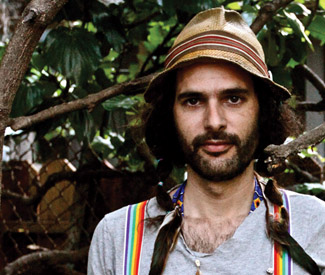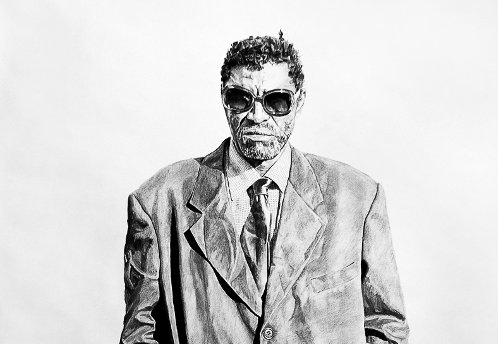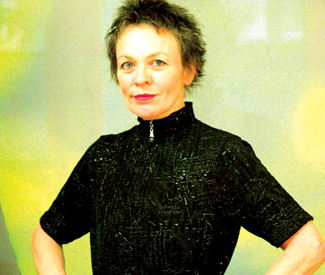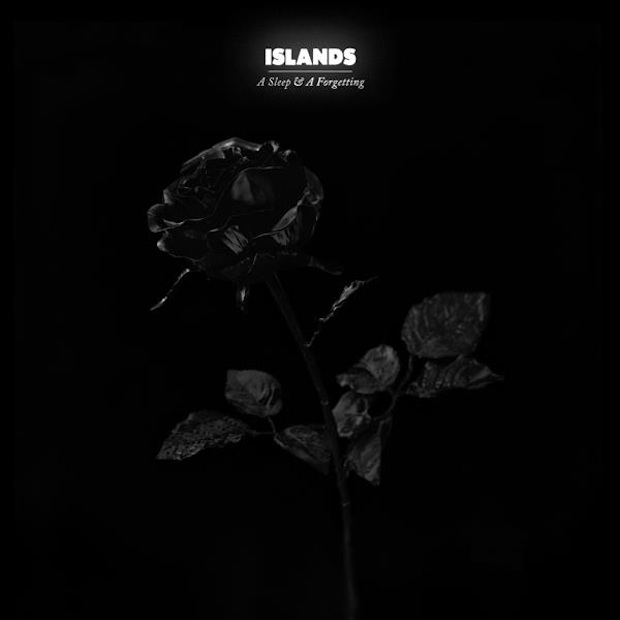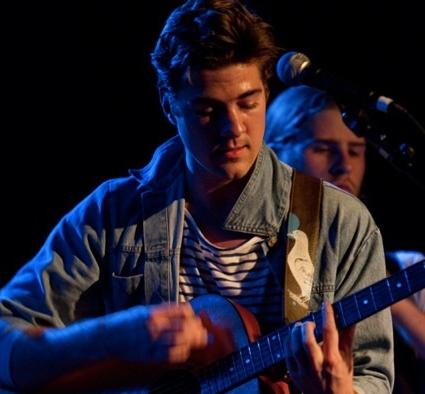Joel Daniel Phillips draws people. He draws them with charcoal and pencil and is known for his life-sized renderings of eccentric, seemingly homeless men and women he meets on the corner of Sixth and Mission Streets in San Francisco.
His debut solo show with Hashimoto Contemporary, “I Am Another Yourself,” opens Sat/6 (opening reception 6-9pm; the show runs through Sept. 27). I met up with Phillips to talk about his work and to see his 14 pieces in person.
As we hung out in his roomy studio in East Oakland, the BART train lumbering by every so often, Phillips’s towering life-sized pieces captured my awe and attention. The details he emphasizes in his work — whether it’s a wrinkled pant leg, a takeout container, lines on a face, or a waning pack of Newport Lights — illustrate the attitude and honesty of his subjects.
“I think of [my work as] a bit like journalism in that the goal is for me to honestly understand something else or someone else and then show it to my audience,” Phillips says.
Phillips moved to San Francisco three years ago. Not knowing a whole lot about the city, he accepted a live-work studio space on Sixth and Mission. Once he arrived in the neighborhood, he realized it was — well, different. So he started his own artistic exploration of the street corner, which involved approaching people he found particularly intriguing, asking if he could take their photographs, and creating life-sized drawings of them.
When considering whom to approach for a photo, Phillips looks for “people who carry their story on their face” or demonstrate their story in the way they dress. These types of people embody the honesty and vulnerability he aims to capture in his pieces.
“I’m fascinated with vulnerability,” Phillips says. “If I approach most people in the street and ask them, ‘Can I take your photograph? I’m an artist,’ they’ll stand in a certain way, pose in a certain way, and have a projected sense of how they want to be perceived. But this particular subset of society doesn’t do that. They allow me into a deeper sense of who they are.”
While people may look at Phillips’s work and assume his drawings are of homeless men and women, that’s not necessarily the case. “A lot of people assume they are all homeless, but I have no idea if any of them are homeless,” Phillips says.
And he doesn’t care to ask his subjects about their living situations, either. “Part of the reason I isolate my subjects from their backgrounds is because I want to remove certain information,” Phillips says. “I want you to take each person out of context and see them as an individual, rather than place them in a certain box.”
A unifying attitude that links Phillips’ subjects seems to be that “these people are in a place, for whatever reason, where they don’t really give a shit. They’ve gone through a lot of things — maybe hard, maybe just different than your average suburban white kid’s experiences — that have put them in a place where they are comfortable,” Phillips says.
He describes his goal as building an emotional and mental bridge between two disparate cultural groups and allowing people to see themselves in these individuals, who are often from a completely different world than their viewers.
Phillips motions toward Spaceman, who’s sporting Ugg boots, a motorcycle helmet, and a creatively tied tie, and is holding a broom in a way that makes it look like a badass accessory. “I’ve drawn Spaceman several times,” he says. Tinesha, another subject of a life-sized drawing, wears dramatic eye shadow along with a puka shell necklace and is holding a to-go container. Phillips speaks highly of Tinesha and says she is incredibly sweet.
Then he shows me Billy, one of his smaller drawings. Billy has a long beard and contemplative eyes. His shirt is tucked into his baggy cargo sweatpants, the cuffs of his light button-down shirt are undone, and his crossed arms frame his layered beaded necklaces. “This is Billy the Prophet,” he says. “I’m not sure if anyone other than me calls him that, but he’s definitely a prophet.”
After perusing his pieces, you might think Phillips is trying to impart some type of social justice-driven message or a call to action against poverty or homelessness. But Phillips says his goal is more about perception than social change. His hope is that if you see these pieces and grapple with this idea of how and why you treat certain people a certain way, then “hopefully the next time you walk by someone on the street you might think about this work and say, ‘Hey, I might not be able to fix shit, but I can at least smile; I can at least say hi.’”
After spending almost three years living at the corner of Sixth and Mission, cheaper rent lured Phillips out to East Oakland in April. He still comes back to his street corner, though. Not just for the next photo, but to continue his friendships with the people he’s photographed. He routinely runs into his subjects – now friends – and buys them lunch or art supplies.
“They know who I am on the street corner now. I’m that guy who draws people. And sometimes people even ask me to draw them,” he says.
Being the guy who draws people has allowed Phillips to become a part of the community. “I’m no longer this gentrifying white presence; I’m not the person who’s trying to change Sixth and Mission from what it’s been. I’m somebody who’s trying to understand what Sixth and Mission is,” Phillips says.
“I Am Another Yourself”
Through Sept. 27
Opens Sat/6, 6-9 pm
Hashimoto Contemporary
804 Sutter, SF
For inquiries, contact Hashimoto Contemporary: hashimotocontemporary@gmail.com
Follow Phillips on Instagram here

